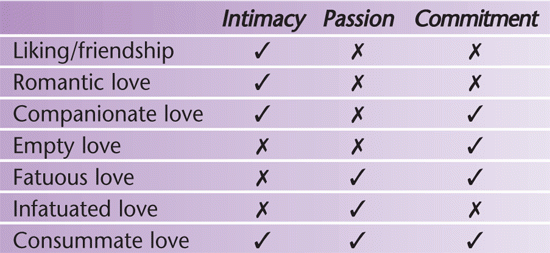Relationship Maintenance & Dissolution
THEORIES OF RELATIONSHIP MAINTENANCE
Social exchange theory (Thibaut and Kelley, 1959)
Satisfaction (profit) is determined by exchange of rewards and costs. There are two comparisons: between actual and expected rewards (comparison level, CL), and the comparison level for alternatives (CLalt). Relationships develop through key stages:
• sampling – explore rewards and costs directly or indirectly (observing others)
• bargaining – prospective partners establish sources of profit and loss
• commitment – routines are established
• institutionalisation – norms and mutual expectations are established.
Research evidence
Rusbult (1983) found that ‘costs’ are only calculated after the honeymoon phase. Simpson et al. (1990) found that participants who were dating rated members of the opposite sex as less attractive, demonstrating that they close themselves off from attractive alternatives.
Evaluation
• Mechanistic approach. In reality it is difficult to define rewards or costs precisely.
• The model doesn’t quantify the point of dissatisfaction.
• Relationship differences. Clark and Mills (1979) argued that romantic relationships are communal rather than exchange relationships.
Equity theory (Walster et al., 1978)
Balance is achieved more through perceived fairness, as in the matching hypothesis. Inequity results in striving to restore balance or in dissolution.
Research evidence
Hatfield et al. (1972) interviewed over 500 students about equity in their relationships. Three months later the inequitable relationships were more likely to have ended.
Evaluation
• Equity may be maintained by matching any ‘attractive’ characteristics, such as physical looks, money or status.
• Individual differences. Individuals low in exchange orientation don’t bother about equity (Buunk and VanYperen, 1991).
• Cultural differences. Equity is not a norm for all cultures.
THEORIES OF RELATIONSHIP DISSOLUTION
Lee’s (1984) stage model
Dissolution is a process taking place over a period of time:
• dissatisfaction – problems recognised
• exposure – problems identified and brought out into the open
• negotiation – discussion about the issues raised during the exposure stage
• resolution attempts – both partners try to find ways of solving the problems
• termination – if the resolution attempts are unsuccessful.
Research evidence
Lee (1984) studied over 100 premarital romantic break-ups, and drew up the five stages. Those relationships that had been the strongest took the longest time to work through the five stages of dissolution.
Duck’s (1984) model of relational dissolution
• Breakdown: dissatisfaction leads to crisis. Repair strategy : correct own faults.• Intra-psychic phase: thinking about the relationship; in private, then with confidants. Repair strategy: re-establish liking for partner.• Dyadic phase: deciding whether to break up or repair. Repair strategy: express conflict, clear the air and reformulate rules for a future relationship.• Social phase: including others in the debate, enlisting support for your ‘side’. - Repair strategy: outsiders may help patch things up or encourage separation.• Grave dressing phase: public and private post-mortem. Repair strategy: decide on a mutually acceptable version of events; salvage friendship.
Evaluation
• Lee’s model is mainly concerned with events leading up to dissolution, whereas Duck’s model concerns processes after breakdown.
• Neither model explains why breakdown occurs; they are descriptive.
Duck’s (1982) risk factors
1 Predisposing personal factors (dispositional): distasteful personal habits, change in interests, poor role models (e.g. parents divorced), poor social skills.
2 Precipitating factors (situational): such as deception, boredom, relocation, conflict.
Evaluation
• These factors offer an explanation for dissolution.
• Many relationships are stable despite the presence of such factors.
• Some of the factors are intervening variables, for example lower educational levels may be associated with divorce but not the cause.
PSYCHOLOGICAL EXPLANATIONS OF LOVE
Romantic and companionate love (Bersheid and Walster, 1978)
Companionate love is an extension of liking. It develops through mutual rewards, familiarity, and tends to deepen over time. Romantic/passionate love is based on intense emotions which often become diluted over time, and a mixture of emotions (e.g. excitement and deep despair).
Sternberg’s (1986) triangular theory of love
• Intimacy (emotional component): mutual understanding and support.
• Passion (motivational): physical attraction, need for self-esteem.
• Decision/commitment (cognitive): short- and longterm decisions.
Evaluation
• Classifications can be used to identify where changes can be made.
• Some of the components are rather vague.
Stemberg Theory of Love

Three-factor theory of love (Hatfield and Walster, 1981)
(i) a state of physiological arousal
(ii) an appropriate label for that arousal (cultural influence) and
(iii) an appropriate love object.
See Schachter and Singer’s (1962) cognitive labelling theory of emotion
Research evidence
Dutton and Aron (1974) arranged for men to be interviewed by an attractive female either on a high suspension bridge (high arousal) or a low bridge. The high arousal condition led to greater attraction presumably because the men misattributed the arousal they felt as sexual attraction rather than fear.
Evaluation
• Can explain cultural differences and ‘love at first sight’.
• May only be relevant to certain love experiences.
